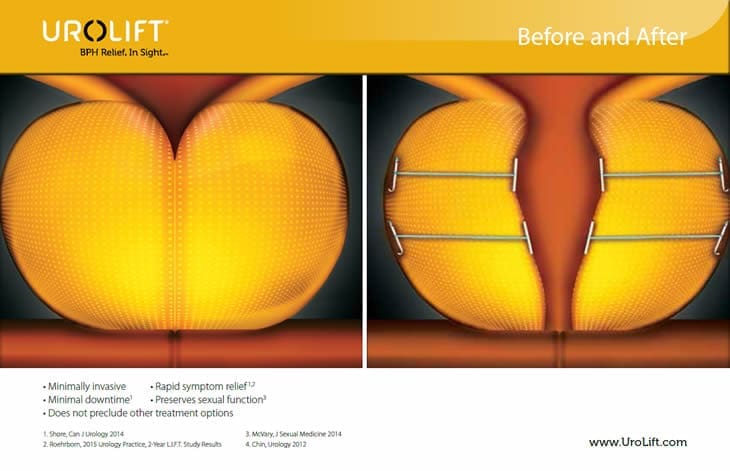Poets and philosophers have long insisted that age brings confidence, wisdom, and freedom. Yet, it can also bring some unwelcome physical changes in men. The urgent need to go, urinating more frequently than normal, a weak urinary stream, difficulty starting and stopping—they’re all symptoms of benign prostatic hyperplasia (BPH). BPH is just a term used for men with increased prostate growth that is not cancerous. It is often used interchangeably with the term “enlarged prostate.” For many men, an enlarged prostate can turn a normal body function into an issue that can interfere with nearly every aspect of daily life.
“After the age of 30 to 40, the prostate begins to grow, so most men experience some form of urinary symptoms related to an enlarged prostate,” says Geoff Nuss, M.D., a board-certified urologist with Urology Partners of North Texas. “In some men, their prostate grows to an enormous size. In others, it doesn’t grow very much at all. Growth is related to an individual’s genetics and other factors that we don’t fully understand.”
Big Prostate, Big Problems
With a healthy prostate, there is a wide-open channel that accommodates the urethra and allows urine to easily flow out of the bladder. With an enlarged prostate, the lobes press on either side of the urethra, cutting off the flow of urine. As a result, the bladder has to generate a lot more pressure to push urine through the urethra.
For some men the blockage and symptoms interrupt their sleep, make it difficult to play a round of golf, go on a trip or just enjoy dinner or a movie out. Instead, their day and night revolve around being close to a bathroom at all times. Some men are hesitant to leave their homes and become shut-ins. Many feel isolated, depressed and sleep-deprived.
“For a large part of our lives, we take urinary function for granted,” says Dr. Nuss. “We don’t want to think about it. When a man has to plan his entire day around it, it takes a toll on his quality of life.”
Giving the Prostate a Lift
Every year, nearly 38 million men visit their doctors looking for help for their BPH symptoms. Transurethral resection of the prostate (TURP) and the laser TURP (also called laser vaporization) are two options, but they can deliver varying results and be accompanied by sexual and urinary side effects. Even popular prescription medications used to treat BPH don’t alleviate symptoms in many men and also have side effects like dizziness and sexual side effects.

The minimally-invasive UroLift doesn’t require cutting, heating or removal of prostate tissue. Instead, a small, permanent implantable device is inserted into the prostate to lift and hold enlarged tissue away from the urethra. Once the enlarged prostate tissue is no longer pressing on the urethra, normal urinary function is restored.
“Because there isn’t any cutting or heating of prostate tissue with the UroLift procedure, men don’t experience erectile dysfunction or a change in ejaculate that is common with the TURP,” Dr. Nuss explains.
The UroLift is a small, implantable device made up of very small hypoallergenic capsules that are put in place with permanent sutures. The capsules are used in pairs to hold enlarged prostate tissue away from the urethra. Most men typically require two sets—four capsules—but additional sets can be required. Over time, the body’s natural tissue grows over the MRI-safe implants, and they usually can’t be detected with ultrasound afterward. Just as importantly, men won’t set off the alarm at the airport security screening line.
The UroLift procedure is routinely performed in an office setting under local anesthesia. Following the procedure, men may experience mild discomfort, some burning during urination and blood in the urine. These symptoms go away fairly quickly, though. “There’s always going to be discomfort with any procedure,” Dr. Nuss says. “But with the UroLift, the discomfort is minimal and lasts for a shorter time than any laser procedure.”
Recovery is fairly quick, and in most cases, men don’t have to wear a catheter while healing.
Life After the Lift
Studies have found the UroLift procedure delivers long-lasting results. “Most men experience the same level of relief five to eight years post procedure that they enjoyed immediately following their UroLift,” Dr. Nuss adds.
In the event additional treatment for BPH is needed later down the road, the UroLift procedure can be repeated, or men can undergo a traditional laser procedure. It’s also important to note that the UroLift procedure doesn’t interfere with prostate cancer treatment.
Is the UroLift Right for You?
If you experience any of the following BPH symptoms, you could be a candidate for the UroLift.
- Need to go frequently
- Weakened stream
- Can’t empty bladder completely
- Start and stop during urination
- Spend more time at the urinal than other men
- Can’t sleep due to frequent nighttime going
A physical exam and conversation with your physician are the first steps in determining if the UroLift may be right for you. All men undergo an ultrasound of the prostate and prostate-specific antigen (PSA) screening to determine if UroLift or another option is the best course of treatment.
“Men don’t have to struggle with BPH,” Dr. Nuss says. “By removing the constant concern about their urinary habits, UroLift is helping a growing number of men enjoy a better quality of life.”
Ready to give your prostate a lift?
Talk with one of our UroLift specialists at Urology Partners. Call 866-367-8768.


